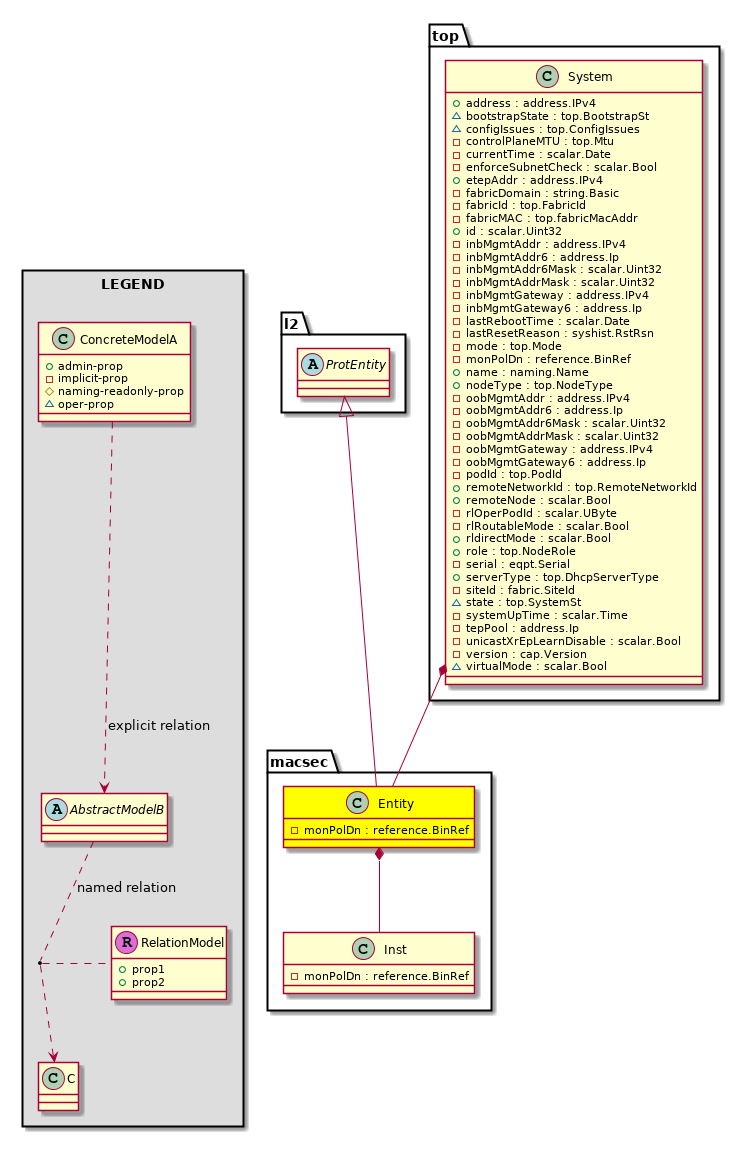![[V]](styles/eye.gif) |
macsec:Entity Holds macsec control plane entity information |
├
|
![[V]](styles/eye.gif) |
fault:Counts An immutable object that provides the number of critical, major, minor, and warning faults raised on its parent object and its subtree. |
├
|
![[V]](styles/eye.gif) |
health:Inst A base class for a health score instance.(Switch only) |
├
|
![[V]](styles/eye.gif) |
macsec:Inst This objects hold per macsec instance information. There is
only one instance of macsec running in the system today |
|
├
|
![[V]](styles/eye.gif) |
fault:Counts An immutable object that provides the number of critical, major, minor, and warning faults raised on its parent object and its subtree. |
|
├
|
![[V]](styles/eye.gif) |
health:Inst A base class for a health score instance.(Switch only) |
|
|
├
|
![[V]](styles/eye.gif) |
fault:Counts An immutable object that provides the number of critical, major, minor, and warning faults raised on its parent object and its subtree. |
|
|
├
|
![[V]](styles/eye.gif) |
fault:Inst Contains detailed information of a fault. This object is attached as a child of the object on which the fault condition occurred. One instance object is created for each fault
condition of the parent object. A fault instance object is identified by a fault code. |
|
|
|
├
|
![[V]](styles/eye.gif) |
aaa:RbacAnnotation RbacAnnotation is used for capturing rbac properties of any apic object
Objects can append rbacannotations as Object->RbacAnnotation which
is then checked for domain eligibility |
|
|
├
|
![[V]](styles/eye.gif) |
health:Inst A base class for a health score instance.(Switch only) |
|
|
├
|
![[V]](styles/eye.gif) |
l2:RsEthIf A source relation to an L1 interface. This is an internal object. |
|
|
├
|
![[V]](styles/eye.gif) |
l2:RsMgmtIf Association to the corresponding mgmt::MgmtIf |
|
|
|
├
|
![[V]](styles/eye.gif) |
aaa:RbacAnnotation RbacAnnotation is used for capturing rbac properties of any apic object
Objects can append rbacannotations as Object->RbacAnnotation which
is then checked for domain eligibility |
|
|
|
├
|
![[V]](styles/eye.gif) |
aaa:RbacAnnotation RbacAnnotation is used for capturing rbac properties of any apic object
Objects can append rbacannotations as Object->RbacAnnotation which
is then checked for domain eligibility |
|
|
|
├
|
![[V]](styles/eye.gif) |
fault:Delegate Exposes internal faults to the user. A fault delegate object can be defined on IFC (for example, for an endpoint group) and when the fault is raised
(for example, under an endpoint policy on a switch), a fault delegate object is created on IFC under the specified object. A fault delegate object follows the lifecycle of the original fault instance object, being created, modified, or deleted based on the changes of the original fault. |
|
|
├
|
![[V]](styles/eye.gif) |
aaa:RbacAnnotation RbacAnnotation is used for capturing rbac properties of any apic object
Objects can append rbacannotations as Object->RbacAnnotation which
is then checked for domain eligibility |
|
|
├
|
![[V]](styles/eye.gif) |
fault:Counts An immutable object that provides the number of critical, major, minor, and warning faults raised on its parent object and its subtree. |
|
|
├
|
![[V]](styles/eye.gif) |
fault:Inst Contains detailed information of a fault. This object is attached as a child of the object on which the fault condition occurred. One instance object is created for each fault
condition of the parent object. A fault instance object is identified by a fault code. |
|
|
|
├
|
![[V]](styles/eye.gif) |
aaa:RbacAnnotation RbacAnnotation is used for capturing rbac properties of any apic object
Objects can append rbacannotations as Object->RbacAnnotation which
is then checked for domain eligibility |
|
|
├
|
![[V]](styles/eye.gif) |
health:Inst A base class for a health score instance.(Switch only) |
|
|
├
|
![[V]](styles/eye.gif) |
l2:RsEthIf A source relation to an L1 interface. This is an internal object. |
|
|
├
|
![[V]](styles/eye.gif) |
l2:RsMgmtIf Association to the corresponding mgmt::MgmtIf |
|
|
|
├
|
![[V]](styles/eye.gif) |
aaa:RbacAnnotation RbacAnnotation is used for capturing rbac properties of any apic object
Objects can append rbacannotations as Object->RbacAnnotation which
is then checked for domain eligibility |
|
|
|
├
|
![[V]](styles/eye.gif) |
aaa:RbacAnnotation RbacAnnotation is used for capturing rbac properties of any apic object
Objects can append rbacannotations as Object->RbacAnnotation which
is then checked for domain eligibility |
|
|
|
├
|
![[V]](styles/eye.gif) |
fault:Delegate Exposes internal faults to the user. A fault delegate object can be defined on IFC (for example, for an endpoint group) and when the fault is raised
(for example, under an endpoint policy on a switch), a fault delegate object is created on IFC under the specified object. A fault delegate object follows the lifecycle of the original fault instance object, being created, modified, or deleted based on the changes of the original fault. |
|
|
├
|
![[V]](styles/eye.gif) |
fault:Delegate Exposes internal faults to the user. A fault delegate object can be defined on IFC (for example, for an endpoint group) and when the fault is raised
(for example, under an endpoint policy on a switch), a fault delegate object is created on IFC under the specified object. A fault delegate object follows the lifecycle of the original fault instance object, being created, modified, or deleted based on the changes of the original fault. |
|

